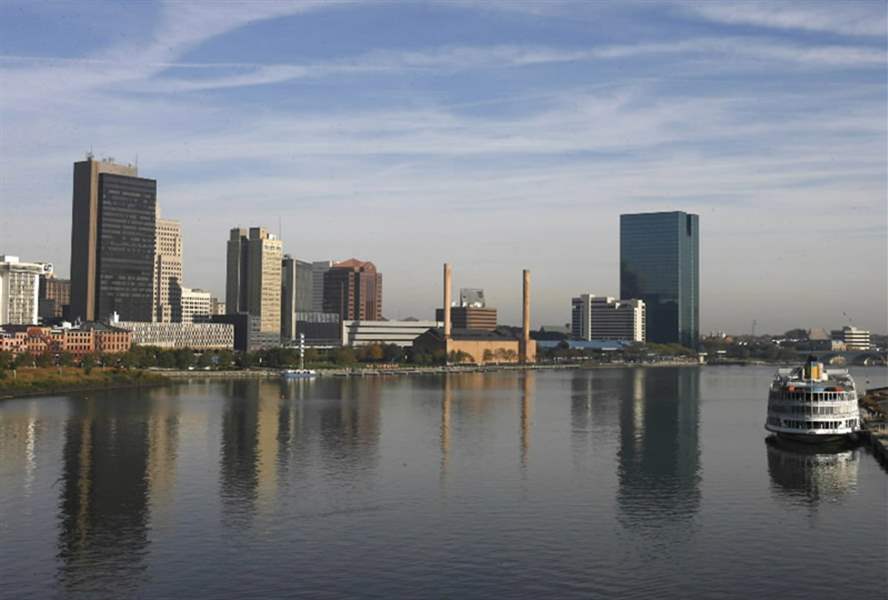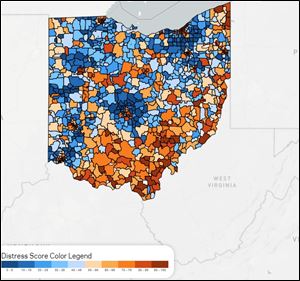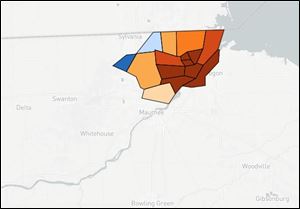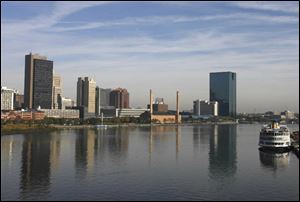
Study shows Toledo among most distressed large U.S. cities
10/6/2017
An annual study ranks Toledo among the most distressed large cities in the nation.
For several years, an economic malaise has covered metro Toledo’s central city neighborhoods, putting those residing there at an employment, educational, and physical disadvantage compared to the rest of the area.
This ongoing problem, which engulfs seven zip codes in the heart of town, places Toledo among the most distressed large cities in the nation, according to an annual study that seeks to find solutions to the dilemma.

Areas in the state of Ohio broken down by their distress score, according to a study by the Economic Innovation Group.
“Over the last five years Toledo has lost 4 percent of its businesses while other parts of the country are gaining businesses,” said John Lettieri, co-founder and senior director for policy & strategy at the Washington, D.C.-based Economic Innovation Group.
“Other places are creating high-wage jobs while Toledo is falling behind your state as a whole. There’s lots of poverty in Toledo, which can be solved by new business opportunities,” Mr. Lettieri said. “But Toledo is still at the bad end of that trajectory. It’s still losing businesses.”
The Economic Innovation Group, a bipartisan entrepreneurial think tank, set out in 2015 to identify the country’s most economically distressed areas. They used Census data and seven metrics to create an interactive Distressed Cities Index.
The index constantly is updated to target for policymakers the places most needing economic assistance.
In the 2015 study, metro Toledo was 14th among 100 large cities in economic distress. But last year it was fourth, and for 2017 it is fifth.
Overall, the city had a distress score of 96.7, with Cleveland heading the list at 100.
The study claims that 51.8 percent of the city of Toledo’s 282,275 residents live in distressed zip codes. Distressed means the zip code had a score of 80 or more on a scale of 100 when compared to its peers.
The Old West End (43620), the Lagrange area (43608), and the City Center/North River (43604) were the most distressed with scores of 99.9, 99.1, and 98.4, respectively.
In the seven metrics, the city of Toledo had a house vacancy rate of 14.8 percent, it had 34.8 percent of prime-age adults not working, a poverty rate of 27.8 percent, median income that was 68.2 percent of the state median, job growth of just 1.6 percent from 2011 to 2015, a decrease of 3.9 percent in business establishments from 2011 to 2015, and 14.8 percent of those over 25 having neither a high school diploma nor a GED.

Toledo's areas broken down by the level of economic distress, according to a study by the Economic Innovation Group.
By contrast, the Sylvania zip code (43560) had a distress score of 13.0, Rossford (43460) 14.2, Maumee (43537) 5.7, and Perrysburg (43551) 11.6.
For all of Lucas County the metrics were: house vacancy 11.7 percent, prime-age adults not working 31.1 percent, poverty 21.1 percent, median income 84.5 percent, job growth 5.6 percent, business establishments down 2.3 percent, and lacking a high school diploma or a GED 11.6 percent.
Steve Glickman, co-founder and executive director of the Economic Innovation Group, said metro Toledo is unlike most cities with large distressed areas.
“Usually when you see a distressed city, you see it distressed across the entire city. But Toledo has a lot of distress in the core of the city,” Mr. Glickman said. “Once you get just outside Toledo it’s doing pretty well. It’s sparked a divide within the city.”
Nationally, the 2017 index found that one in six Americans live in a distressed zip code, and more than half of the U.S. population in the South lives in distressed zip codes. Mississippi and Alabama have the highest share of populations in distressed zip codes while Utah and Minnesota have the highest share of populations in prosperous zip codes.
Distressed zip codes share many negative aspects. They are the places in which both the number of jobs and businesses declined during the recovery following the 2009 recession and they contain fewer jobs and businesses than they did in 2000.
Distressed zip codes contain 35 percent of the country’s brownfield sites, and 58 percent of adults living in the zip codes have no education beyond high school.
But the study also found a physical cost for those residing in distressed zip codes. People die there five years sooner than those in prosperous zip codes. Males live on average to age 72, compared to 78 in prosperous zip codes, while women live on average to age 78, compared to 82.
Mortality rates from cancers, pregnancy complications, suicides, and violence are all elevated in distressed zip codes. Twice as much Medicaid spending goes to distressed counties (which tend to be rural) per capita as to prosperous ones.
The study found that, geographically, older cities with long industrial legacies are most likely to be distressed. In the most distressed large cities, of which Toledo is fifth, age tends to be a burden — for example, the median homes in Detroit and Philadelphia were built 68 years ago and contribute to high housing vacancy rates and discourage residential investment.
By contrast, in Gilbert, Ariz., the most prosperous city, the median home is just 15 years old, and Austin, Texas, a city that has overcome problems to develop a mature economy, the median home is 29 years old.
Mr. Lettieri said metro Toledo’s long legacy of glass and auto making does hinder its ability to create a better economy. But that’s only from relying too heavily on those legacy industries.
“The auto industry can be an advantage. You don’t want to look at that as a burden but as a strength. But it’s just a question of proportionality,” he said.
City policymakers, he said, should alternately be looking at ways to encourage entrepreneurship so that smaller businesses can start and thrive, he said.
“It’s about nibbling around at the edges of entrepreneurship and not being overly dependent on one type of industry or employer. It’s not easy to wean yourself off of that and start building a new industry around it,” he said.
In its 2016 report, the Economic Innovation Group discussed how some metro areas like Austin, Charlotte, Denver, and Seattle had been using a “return to the city” narrative to encourage growth in distressed central city areas, but noted that the trend largely had bypassed Midwest cities.

An annual study ranks Toledo among the most distressed large cities in the nation.
Downtown Toledo, though, is going through a redevelopment thanks to an investment by ProMedica, which shifted its headquarters to the riverfront, brought 1,100 workers downtown and has spurred new investment.
Mr. Glickman said that is a good formula for aiding the city’s distressed areas.
“All those things are kind of the key parts to the equation of how to turn a place around, with a couple of caveats,” he said.
“Population drift is a long-term trend. It dates back decades, and you still have population leaving today with a big dip during the recession in 2000,” he said.
Making downtown “a much more interesting place to work and live” is a good way to attract young people back to the city, he added.
However, Mr. Glickman said that the city is still tied heavily to glass production and manufacturing, and needs to develop a more diverse economy, starting with developing smaller businesses. “It’s going to take a long time for Toledo to compete with other parts of the country,” he said.
Mr. Lettieri said to develop an entrepreneurial environment where small start-ups can thrive, an area like Toledo needs better access to capital — something greatly lacking in the Midwest.
Congressman Pat Tiberi (R., Ohio), whose district includes Columbus, is among those trying to level that playing field through his Investing in Opportunity Act, a bipartisan piece of legislation introduced in 2016 that seeks to provide access to capital to areas that normally don’t see it — such as cities like Toledo.
The Act would do three things. It would create “Opportunity Zones” in each state in which investors would get incentives to invest capital in new and small businesses. It would make it easier for investors to roll existing capital into “Opportunity Funds” that could be used for early-stage businesses. Lastly, it would encourage long-term investor commitments by eliminating capital gains for certain types of investments.
At a Congressional Joint Economic Committee hearing, Mr. Tiberi, the first in his family to finish high school and someone who grew up in a immigrant household that knew economic struggles, said something needs to be done to encourage more investment in distressed areas.
“From 2010 to 2014 half of all business growth occurred in just five metropolitan areas. Blighted areas across the country are desperate for new businesses and the jobs and opportunities that come with them,” he said. “That is why I introduced the bipartisan Investing in Opportunity Act, to attract capital and investment in distressed communities, and I hope it can become part of tax reform."
Contact Jon Chavez at: jchavez@theblade.com or 419-724-6128.